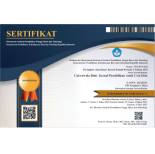Comparison of Early Childhood Asthenopia Levels Between Traditional Marsitekka or Engklek Guess The Picture Games and Digital Games
Abstract
Keywords
Full Text:
PDFReferences
Anggraeni, S. (2019). Pengaruh pengetahuan tentang dampak gadget pada kesehatan terhadap perilaku penggunaan gadget pada siswa SDN Kebun Bunga 6 Banjarmasin. Faletehan Health Journal, 6(2), 64–68. https://doi.org/10.33746/fhj.v6i2.68
Ariston, Y., dan Frahasini, F. (2018). Dampak penggunaan gadget bagi perkembangan sosial anak sekolah dasar. Journal of Educational Review and Research, 1(2), 86-91. http://dx.doi.org/10.26737/jerr.v1i2.1675
Darmawati, N. B., dan Widyasari, C. (2022). Permainan tradisional engklek dalam meningkatkan motorik kasar anak usia dini. Jurnal Obsesi: Jurnal Pendidikan Anak Usia Dini, 6(6), 6827–6836. https://doi.org/10.31004/obsesi.v6i6.3487
Gumunggilung, D., Doda, D. V. D., dan Mantjoro, E. M. (2021). Hubungan jarak dan durasi pemakaian smartphone dengan keluhan kelelahan mata pada mahasiswa fakultas kesehatan masyarakat UNSRAT di era pandemi Covid-19. KESMAS: Jurnal Kesehatan Masyarakat Universtas Sam Ratulangi, 10(2), 12-17. https://ejournal.unsrat.ac.id/index.php/kesmas/article/vieaw/32270
Hayati, S. N., dan Putro, K. Z. (2021). Bermain dan permainan anak usia dini. Generasi Emas: Jurnal Pendidikan Islam Anak Usia Dini, 4(1), 52–64. https://doi.org/10.25299/jge.2021.vol4(1).6985
Hidayatuladkia, S. T., Kanzunnudin, M., dan Ardianti, S. D. (2021). Peran orang tua dalam mengontrol penggunaan gadget pada anak usia 11 tahun. Jurnal Penelitian Dan Pengembangan Pendidikan, 5(3), 363-372. https://doi.org/10.23887/jppp.v5i3.38996
Lanca, C., and Saw, S. M. (2020). The association between digital screen time and myopia: A systematic review. Ophthalmic and Physiological Optics, 40(2), 216-229. https://doi.org/10.1111/opo.12657
Nailufar, F., Ulfah, M., Nuraeni, S., Syahriani, S. S., dan Santoso, S. A. (2023). Pengenalan permainan tradisional engklek kepada anak usia dini. Jurnal Abdidas. 4(3), 272-280.
Nur, H., dan Asdana, M. F. (2020). Pergeseran permainan tradisional di Kota Makassar. Phinisi Integration Review, 3(1), 17–29. https://doi.org/10.26858/v3i1.13131
Pratama, P. P. A. I., Setiawan, K. H., dan Purnomo, K. I. (2021). Asthenopia: Diagnosis, tatalaksana, terapi. Ganesha Medicine Journal, 1(2), 97-102. https://doi.org/10.23887/gm.v1i2.39551
PremKumar, U., J, P., Fahima, S., Anil, A., V, B., A, A., S, A., and Shaik, A. S. (2019). Third Eye Syndrome- a gadget screen addiction among medical professionals in Chennai, Tamilnadu, India. National Journal of Research in Community Medicine, 8(3), 249–254. https://doi.org/10.26727/njrcm.2019.8.3.249-254
Rahayu, N. S., Elan, E., dan Mulyadi, S. (2021). Analisis penggunaan gadget pada anak usia dini. Jurnal PAUD Agapedia, 5(2), 202–210. https://doi.org/10.17509/jpa.v5i2.40743
Raihana, R., dan Sari, B. F. (2021). Pengaruh permainan tradisional engklek terhadap perkembangan fisik motorik kasar anak usia 5-6 tahun. GENERASI EMAS: Jurnal Pendidikan Islam Anak Usia Dini, 4(2), 1–10. https://doi.org/10.25299/ge:jpiaud.2021.vol4(2).6743
Simamora, Y. A., and Sibarani, R. (2022). Tradisi permainan rakyat pada Etnik Batak Toba: Kajian kearifan lokal. Journal of Language Development and Linguistics, 1(2), 71–86. https://doi.org/10.55927/jldl.v1i2.1248
Ulfah, S. M., Munandar, A., dan Ahmad, A. (2024). Desain model permainan kreatif tradisional ramah anak dalam meningkatkan kemampuan kognitif anak usia dini. Kiddo: Jurnal Pendidikan Islam Anak Usia Dini, 247-260. https://doi.org/10.19105/kiddo.v1i1.13075
Yani, I. (2017). Stimulasi perkembangan anak melalui permainan tradisional Suku Batak Toba. JIV-Jurnal Ilmiah Visi, 12(2), 89–98. https://doi.org/10.21009/JIV.1202.1
Yuniarni, D. (2019). Peran guru paud dalam meminimalisir dampak gadget pada perkembangan anak usia dini melalui permainan tradisional. Yaa Bunayya: Jurnal Pendidikan Anak Usia Dini, 3(1), 1–6. https://doi.org/10.24853/yby.3.1.1-6
Yurika, T., Nurjannah, N., Basri, S., Ishak, S., dan Hajar, S. (2022). Pengaruh penggunaan gadget dengan kejadian mata lelah pada siswa SMA selama masa pandemi COVID-19. Jurnal Kedokteran Syiah Kuala, 22(2), 60-65. 10.24815/jks.v22i2.22637
Zahra, A. D. (2023). Dampak paparan game online pada anak usia dini. Jurnal Pendidikan Edukasi Anak, 2(1), 156–166. https://journal.umpalopo.ac.id/index.php/jpea/article/view/238
Zogara, A. M. A. (2023). Hubungan intensitas pencahayaan dengan kelelahan mata pada gamer. Jurnal Ilmiah Kesehatan Media Husada, 12(2), 172-181. https://doi.org/10.33475/jikmh.v12i2.322
DOI: https://doi.org/10.17509/cd.v15i2.63167
Refbacks
- There are currently no refbacks.
Copyright (c) 2024 UPI Kampus Cibiru

This work is licensed under a Creative Commons Attribution-ShareAlike 4.0 International License.
Cakrawala Dini: Jurnal Pendidikan Anak Usia Dini
Published in collaboration Program Studi PGPAUD UPI Kampus Cibiru, APG PAUD Indonesia, and PPJ PAUD Indonesia

Cakrawala Dini: Jurnal Pendidikan Anak Usia Dini is licensed under a Creative Commons Attribution-ShareAlike 4.0 International License.
Based on a work at https://ejournal.upi.edu/index.php/cakrawaladini.














